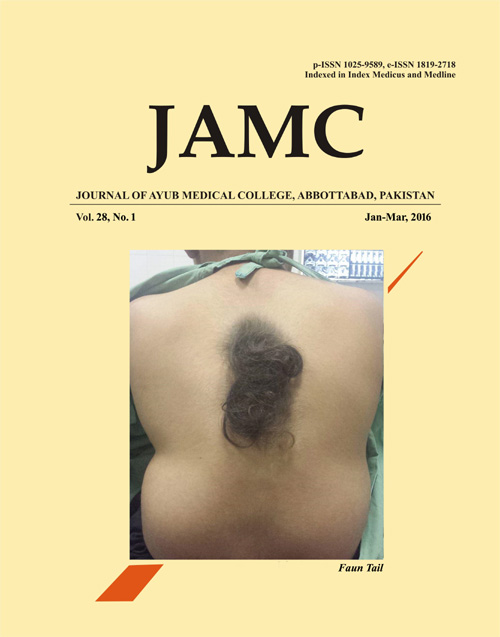PERSPECTIVES REGARDING ANTENATAL CARE, DELIVERY AND BREAST FEEDING PRACTICES OF WOMEN FROM BALUCHISTAN, PAKISTAN
Abstract
Background: Antenatal Care is one of the fundamental rights for women to safeguard their health. Neonatal mortality rates have remained relatively static, compared to the decline in infant and under 5 mortality rates, adverse practices regarding breast feeding and pre-lacteal feeds being the important factors responsible. This study aimed to explore the Antenatal Care, delivery and breastfeeding practices in three districts of Baluchistan. Methods: It was a qualitative phenomenological design using Constructivist approach. The study was conducted in three districts of Baluchistan province, Gwadar, Quetta, Qila Saifullah. There were a total of 14 Focus Group Discussions with women regarding Antenatal Care, delivery and Breastfeeding practices, followed by audio taping, transcription as verbatim and analysis through Nvivo version 2. A process was deployed for identification and reporting of the components in order to ensure quality and validity of the qualitative findings. Results: Across the sites, women attended ANC at least once. However, their descriptions of ANC often varied. The women preferred Dais instead of doctors, due to the affordability, customs and availability. A lack of trained doctors and long distances to get a check-up lead to home deliveries in the study setting. Colostrum was discarded by majority of the mothers, while prelacteal feed was a common practice. Conclusion: This paper has explored factors affecting ANC attendance, delivery and breast feeding practices across three settings. Both the demand and supply side factors have an important influence on practices.
References
Zureick-Brown S, Newby H, Chou D, Mizoguchi N, Say L, Suzuki E, et al. Understanding Global Trends in Maternal Mortality. Int Perspect Sex Reprod Health 2013;39(1):32-41.
Pell C, Meñaca A, Were F, Afrah NA, Chatio S, Manda-Taylor LM, et al. Factors Affecting Antenatal Care Attendance: Results from Qualitative Studies in Ghana, Kenya and Malawi. PLoS One 2013;8(1):e53747.
Finlayson K, Downe S. Why Do Women Not Use Antenatal Services in Low- and Middle-Income Countries? A Meta-Synthesis of Qualitative Studies. PLoS Med 2013;10(1): e1001373.
Pakistan Demographic and Household Survey (PDHS) 1990-91. National Institute of Population Studies Islamabad, Pakistan. [Internet]. [Cited 2015 Sep 5] [Available from:
http://dhsprogram.com/pubs/pdf/FR29/FR29.pdf]
Shah N, Rohra DK, Shams H, Khan NH. Home deliveries: reasons and adverse outcomes in women presenting to a tertiary care hospital. J Pak Med Assoc 2010;60(7):555-8.
Lingam R, Gupta P, Zafar S, Hill Z, Yousafzai A, Iyengar S, et al. Understanding care and feeding practices: building blocks for a sustainable intervention in India and Pakistan. Ann N Y Acad Sci 2014;1308:204-17.
Black RE, Allen LH, Bhutta ZA, Caulfield LE, de Onis M, Ezzati M, et al. Maternal and child under nutrition: global and regional exposures and health consequences. Lancet 2008;371(9608):243-60.
Health Facility Assessment - Balochistan Provincial Report. TRF, Pakistan; 2012.
[Online]. [Cited 2015 Sep 7] [Available from:
http://www.trfpakistan.org/LinkClick.aspx?fileticket=TT1m8C85qdk%3D&tabid=2618]
District Development Profile, Quetta. Planning & Development Department, Government of Balochistan, Quetta UNICEF; 2011.
[Internet]. [Cited 2015 Sep 7] [Available from:
http://balochistan.gov.pk/DistrictProfile/DDP%20Final%202012/Quetta/Quetta.pdf]
Government of Balochistan and IUCN Pakistan. QilaSaifullah: Integrated Development Vision. IUCN Pakistan, Quetta, Pakistan; 2007.
[Internet]. [Cited 2015 Sep 7] [Available from:
Fawole AO, Okunlola MA, Adekunle AO. Clients' perceptions of the quality of antenatal care. J Natl Med Assoc 2008;100(9):1052-8.
Ayaz S, Efe SY. Potentially harmful traditional practices during pregnancy and postpartum. Eur J Contracept Reprod Health Care 2008;13(3):282-8.
Pembe AB, Urassa DP, Carlstedt A, Lindmark G, Nystrom L, Darj E. Rural Tanzanian women's awareness of danger signs of obstetric complications. BMC Pregnancy Childbirth 2009;9:12.
Jalal S, Shah NA. Ante Natal Care (ANC) seeking behavior among women living in an urban squatter settlement: results from an ethnographic study. Ital J Public Health 2011;8(3).
Darmstadt GL, Bhutta ZA, Cousens S, Adam T, Walker N, de Bernis L. Evidence-based, cost-effective interventions: how many newborn babies can we save? Lancet 2006;365(9463):977-88.
Reidpath DD, Morel CM, Mecaskey JW, Allotey P. The Millennium Development Goals Fail Poor Children: The Case for Equity-Adjusted Measures. PLoS Med 2009;6(4):e1000062.
Inayati DA, Scherbaum V, Purwestri RC, Hormann E, Wirawan NN, Suryantan J, et al. Infant feeding practices among mildly wasted children: a retrospective study on Nias Island, Indonesia. Int Breastfeed J 2012;7(1):3.
Raina S K, Mengi V, Singh G. Differentials in colostrum feeding among lactating women of block RS Pura of J and K: A lesson for nursing practice. Iran J Nurs Midwifery Res 2012;17(5):386-9.
Kent JC. How breastfeeding works. J Midwifery Womens Health 2007;52(6):564-70.
Downloads
Published
How to Cite
Issue
Section
License
Journal of Ayub Medical College, Abbottabad is an OPEN ACCESS JOURNAL which means that all content is FREELY available without charge to all users whether registered with the journal or not. The work published by J Ayub Med Coll Abbottabad is licensed and distributed under the creative commons License CC BY ND Attribution-NoDerivs. Material printed in this journal is OPEN to access, and are FREE for use in academic and research work with proper citation. J Ayub Med Coll Abbottabad accepts only original material for publication with the understanding that except for abstracts, no part of the data has been published or will be submitted for publication elsewhere before appearing in J Ayub Med Coll Abbottabad. The Editorial Board of J Ayub Med Coll Abbottabad makes every effort to ensure the accuracy and authenticity of material printed in J Ayub Med Coll Abbottabad. However, conclusions and statements expressed are views of the authors and do not reflect the opinion/policy of J Ayub Med Coll Abbottabad or the Editorial Board.
USERS are allowed to read, download, copy, distribute, print, search, or link to the full texts of the articles, or use them for any other lawful purpose, without asking prior permission from the publisher or the author. This is in accordance with the BOAI definition of open access.
AUTHORS retain the rights of free downloading/unlimited e-print of full text and sharing/disseminating the article without any restriction, by any means including twitter, scholarly collaboration networks such as ResearchGate, Academia.eu, and social media sites such as Twitter, LinkedIn, Google Scholar and any other professional or academic networking site.










